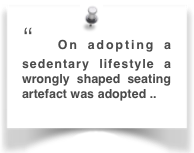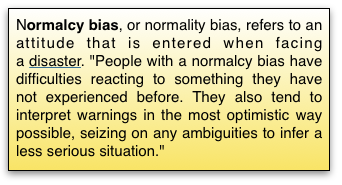Familiarity bias is a factor in holding back the development of ergonomic seating. Efforts at remediation of upright seating seem to have come to the end of the road. To address the epidemic of LBP a paradigm change is required.
‘Familiarity’, ‘Confirmatory’ and ‘Normalcy’ bias is recognised by Behavioural Psychologists as Cognitive dissonance, first described by Leon Festinger in 1957. It is the condition described as the unease felt by people whose experience or information is inconsistent to other, usually already held, beliefs. Information and situations are avoided In an effort to reduce this discomfort and regain psychological consistency. It can be a factor leading to serious, even catastrophic, situations.
The general familiarity bias ….
We are hardwired to believe the world we live in today and to which we are acclimatised so that we b ecome incapable of comprehending and believing that change is coming. In general most users have been commanded, since nursery days, to ’Sit up straight’ or worse ’Stop tilting your chair forward’, a normal response of a child to adopt an actual correct position. Later ‘expert’ advice on ‘correct’ sitting upright is given with authority. This is inspite of having been demolished by AC Mandal back in 1985 (See→Why? Mandal’s Homo sedens. ). This mistaken view of correct seating is still accepted and widely promulgated by authorities who advise on such matters.
ecome incapable of comprehending and believing that change is coming. In general most users have been commanded, since nursery days, to ’Sit up straight’ or worse ’Stop tilting your chair forward’, a normal response of a child to adopt an actual correct position. Later ‘expert’ advice on ‘correct’ sitting upright is given with authority. This is inspite of having been demolished by AC Mandal back in 1985 (See→Why? Mandal’s Homo sedens. ). This mistaken view of correct seating is still accepted and widely promulgated by authorities who advise on such matters. 
The bias holdup
Failure to understand familiarity bias I have found pervasive among chair designers. Peter Bessey comments in this work (→COMFORT) “Introducing medical-based information to designers and their education, at an early stage in their careers, would be a good way to change the status quo. The question is: how do you get that over to them in a lucid and easily digested manner? It needs to be described and presented in an easily accessible manner and not necessarily couched purely in medico-scientific terminology.” In other words, they are really not up to speed on the scientific evidence.
 Normalcy bias is slightly different and can lead to serious problems for firms, however big. It is a dangerous trap for manufacturers of ergonomic office chairs, who may be perfectly happy with the status quo, to fall into and it can blind recognition to a very real and credible threat.
Normalcy bias is slightly different and can lead to serious problems for firms, however big. It is a dangerous trap for manufacturers of ergonomic office chairs, who may be perfectly happy with the status quo, to fall into and it can blind recognition to a very real and credible threat.
People normally think that the experts are correct. They have the top jobs and the top positions in the professions and universities, and so generally that’s true. Until the next scientific advance arrives. A scientist at CERN explained “you know, so far my theory is safe, but it might – you know, ask me next week, they might have found out that I’ve been wrong my entire career”. Good scientists are prepared to admit this but most people are overwhelmed by familiarity bias.
The Ptolemaic system of astronomy seemed to make sense of what was observed in the sky above, that the earth is the centre of the universe. It worked for 1,500 years even becoming a tenet of Christianity, until Galileo made the mistake of inventing a telescope and Copernicus showed, scientifically, that it was wrong. The Christian was an example of familiarity bias. There’s now new research coming out on what’s called the double split experiment, which is a major contributor to the understanding we have of quantum mechanics, which is now maybe violating the popular interpretation of that, 70 or 80 years after it was made. Change can be slow. That misplaced advice on ‘correct’ sitting posture is an example.
It is not surprising that most people have difficulty in over-coming the ‘familiarity bias’ engendered. The exception are many backache sufferers and the younger, millennial, generation who are capable of thinking ‘sideways’.
My own initial training in Biology has made me mistrust sudden jumps (large mutations) in ‘natural selection’ as these are usually deleterious. It is small incremental advances over time that result in progress. The same can be applied to political ideology which has made me a conservative. However when real scientific evidence advances it may be time to change. The 2T or 4M concept, in terms of chair design is only an incremental change. Most office chairs need only modifications. But as a concept it seems to excite cognitive dissonance and be regarded as a ‘paradigm’ shift.
Comment
From Prof. MC Boulter
The comments in your interesting blog remind me of the theme that d’Arcy Thompson used to preach a century ago. He must have influenced you also.
Best wishes
– Michael
d’Arcy Thompson, I think, had a mathematical approach to development and did not understand evolution by natural selection, which is my approach. I see the 2T concept as an incremental change, along the lines of development by natural selection. In the world of chair design the 2T concept is perceived as a ‘paradigm change’, a reclined instead of an upright posture, and I have to accept that as being so and say so. These alternate viewpoints may make my explanation sound contradictory and excite cognitive dissonance.
